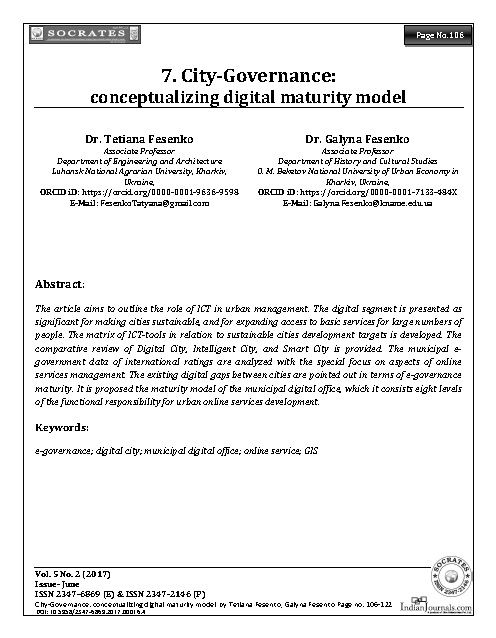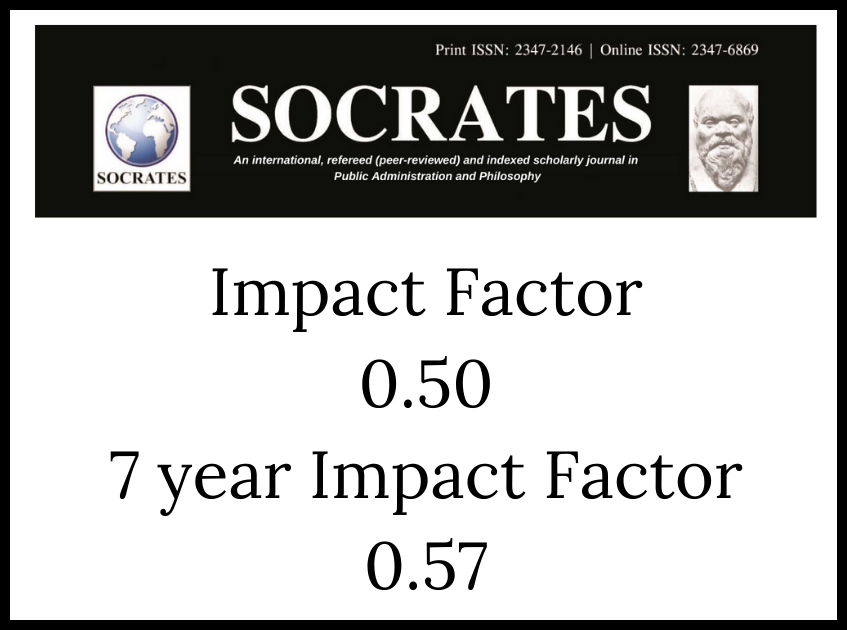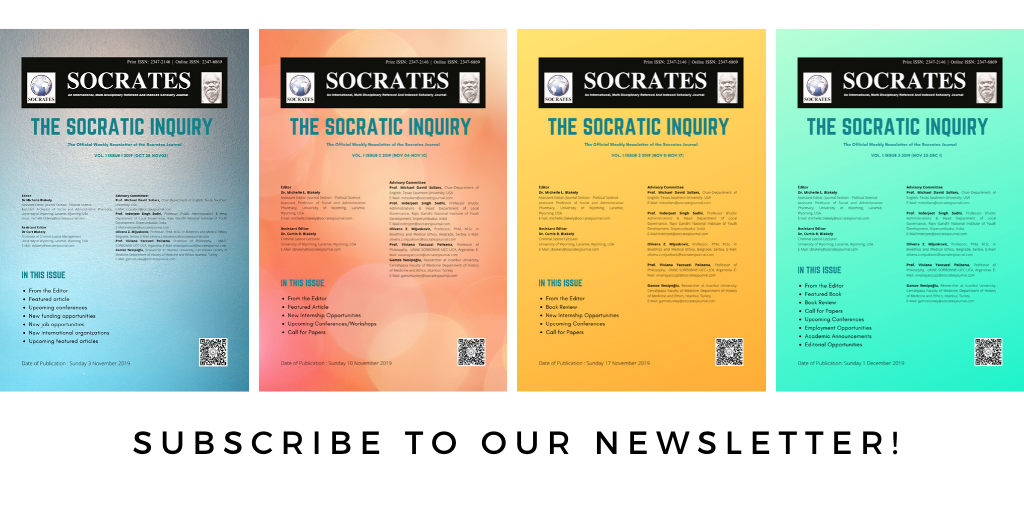City-Governance
conceptualizing digital maturity model
DOI:
https://doi.org/10.5958/2347-6869.2017.00016.4Keywords:
e-governance, digital city, municipal digital office, online service, GISAbstract
The article aims to outline the role of ICT in urban management. The digital segment is presented as significant for making cities sustainable, and for expanding access to basic services for large numbers of people. The matrix of ICT-tools in relation to sustainable cities development targets is developed. The comparative review of Digital City, Intelligent City, and Smart City is provided. The municipal e-government data of international ratings are analyzed with the special focus on aspects of online services management. The existing digital gaps between cities are pointed out in terms of e-governance maturity. It is proposed the maturity model of the municipal digital office, which it consists eight levels of the functional responsibility for urban online services development.
Article DOI : 10.5958/2347-6869.2017.00016.4
Downloads
Metrics
References
Chandra, S. (2016). E-Government in India: The need to ponder current e-government uptake. SOCRATES. 4(3), 35-46. Retrieved from http://socratesjournal.com/index.php/socrates/article/view/236.
Estevez, E., Lopes, N. & Janowski, T. (2016). Smart sustainable cities – reconnaissance study. United Nations University. Retrieved from https://joinup.ec.europa.eu/sites/default/files/smart_cities_report.pdf.
Fesenko, G. and Fesenko, T. (2017). E-Government development strategies in the Eastern Partnership countries. SOCRATES. 5(1), 51-63. doi: 10.5958 / 2347-6869.2017.00007.3.
Fesenko, T. and Fesenko, G. (2016). E-Readiness evaluation modelling for the monitoring programs E-Government at the national level (for the example of Ukraine). Easten-European Journal of Interiorise Technologies. 3(81), 28-35. doi: 10.15587/1729-4061.2016.71606.
Fesenko, T., Fesenko, G. and Bibik, N. (2017). The safe city: developing of GIS tools for gender-oriented monitoring (on the example Kharkiv city, Ukraine). Eastern-European Journal of Interiorise Technologies. 3/2(87), 25-33. doi: 10.15587 / 1729-4061.2017.103054.
Holzer, M. & Manoharan, A.P. (2016). Digital governance in municipalities worldwide (2015-16). Seventh global e-governance survey: a longitudinal assessment of municipal websites throughout the world. Newark: National Center for Public Performance. Retrieved from https://www.seoulsolution.kr/en/content/rutgers-spaa-digital-governance-municipalities-worldwide-2015-16.
Kaylor, C. H. (2005). E-government. The next wave of e-government: The challenges of data architecture. Bulletin of the American Society for Information Science and Technology. 31(2), 18-22. doi: 10.1002 / bult.1720310207.
Kendall, G.I. and Rollins, S.C. (2003). Advanced Project Portfolio Management and the PMO: Multiplying ROI at Warp Speed. Boca Ration: J. Ross Publishing.
Smart Cities: Governing, Modelling and Analysing the Transition. (2014). In Deakin M. (ed.). London: Routledge.
UN-HABITAT 2004: Urban Governance Index: conceptual foundation and field test report. Global Campaign on Urban Governance; Global Urban Observatory.
UN-HABITAT 2015: E-Governance and urban policy design. Nairobi : UN-Habitat Copyright.
United Nations E-Government Survey 2016: E-Government in Support of Sustainable Development. New York: Department of Economic and Social Affairs. Retrieved from http://workspace.unpan.org/sites/Internet/Documents/UNPAN96407.pdf.

Downloads
Published
How to Cite
Issue
Section
License
Copyright (c) 2017 Tetiana Fesenko, Dr., Galyna Fesenko, Dr.

This work is licensed under a Creative Commons Attribution-NonCommercial 4.0 International License.
Revised Copyright/CC license that applies to all the articles published after 05-02-2017
Attribution-NonCommercial 4.0 International (CC BY-NC 4.0)

Copyright/CC license that applies to all the articles published before 05-02-2017
Attribution-Non Commercial-No Derivatives 4.0 International (CC BY-NC-ND 4.0)

Author(s) will retain all the right except commercial and re-publishing rights. In the case of re-publishing, they will have to obtain written permission from the journal. Additional licensing agreements (Creative Commons licenses) grants rights to readers to copy, distribute, display and perform the work as long as you give the original author(s) credit, they can not use the works for commercial purposes and are not allowed to alter, transform, or build upon the work. For any reuse or distribution, readers and users must make clear to others the license terms of this work. Any of these conditions can be waived if you get permission from the copyright holders. Nothing in this license impairs or restricts the authors’ rights. To view a copy of this license, visit http://creativecommons.org/licenses/by-nc-nd/4.0/ or send a letter to Creative Commons, 171 Second Street, Suite 300, San Francisco, California, 94105, USA.
Research Papers published in SOCRATES are licensed under an Attribution-NonCommercial-NoDerivatives 4.0 International (CC BY-NC-ND 4.0)
























